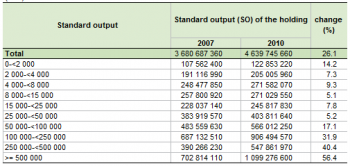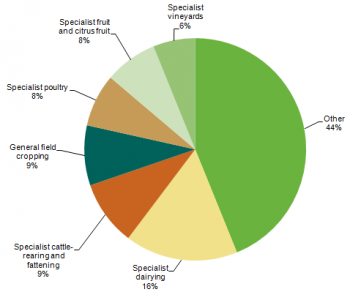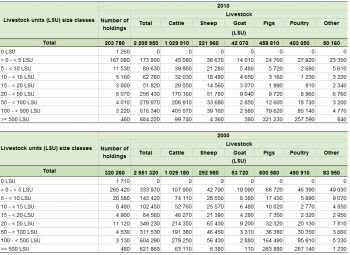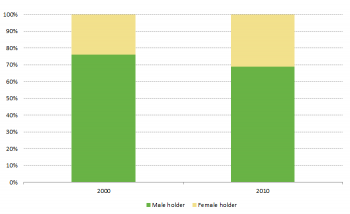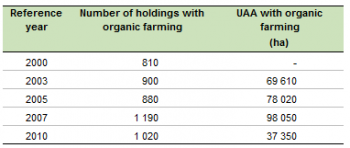Archive:Agricultural census in Portugal
This article has been archived.
This article is part of a series of country-specific essays on the results of the European Union (EU) Farm structure survey (FSS) 2010. The FSS collects information on the structural characteristics of the agricultural holdings (land use, livestock and labour force) and is carried out by all European Union Member States every 10 years as an Agricultural census, with two or three additional, intermediate sample surveys carried out in-between. In Portugal, the present analysis of the farm structure includes a comparison with the previous (2000) Agricultural census. Although the reference years of the Agricultural census in Portugal were 1999 and 2009 respectively, the common designation is Agricultural census 2000 and 2010.

Source: Eurostat (ef_kvaareg) (ef_ov_kvaa) (demo_pjan) and FSS 2000 and 2010

Source: Eurostat (ef_kvaareg) (ef_ov_kvaa) and FSS 2000 and 2010
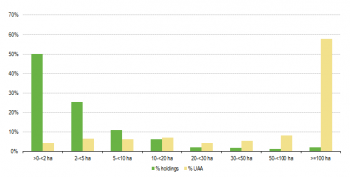
Source: Eurostat (ef_kvaareg) (ef_ov_kvaa)
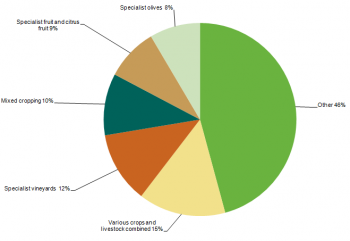
Source: Eurostat (ef_kvftreg)

Source: Eurostat (ef_lu_ovcropaa) (ef_oluaareg)
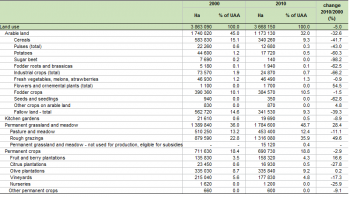
Source: Eurostat (ef_lu_ovcropaa) (ef_oluaareg)

Source: Eurostat (ef_mptenure) (ef_so_mptenure)

Source: Source: Eurostat (ef_pmhouscatlaa)
Main statistical findings
Key indicators
In 2010 there were 305 270 agricultural holdings in Portugal. Since 2000 the number of agricultural holdings decreased by 26.6 %, following the general pattern of the European agriculture. This means that during the 2000-2010 decade one in every four farms closed down.
The utilised agricultural area (UAA) represents 40 % of the Portuguese territory. From 2000 to 2010, the UAA decreased by 5 %. The average size of the holdings increased from 9 to 12 ha. This increase in size was the direct effect of the bigger holdings absorbing the smaller ones that had closed down. When looking at the animal livestock expressed in livestock units (LSU), it can be observed that in 2010 2.2 million LSU were recorded in Portugal. This represents a decrease of 0.3 million LSU (-14 %) when compared to 2000.
Between 2000 and 2010, the number of persons working in agriculture dropped by one third (from roughly 1 million to 0.7 million). However, this number still represents 13.5 % of the economically active population of Portugal.[1]
According to the latest structural agricultural data available, there are on average 0.35 hectares of UAA per inhabitant in Portugal: the equivalent of an area of a square with 60 meter sides. This figure represents a slight decrease from the figure recorded in the previous Agricultural census, when the UAA per inhabitant was 0.38 hectares.
Regional key indicators
When comparing the 2000 data with the 2010 data, the structure of farms appears to vary significantly among the different regions of Portugal. The Alentejo region – which represents almost 56 % of the UAA and 30 % of the LSU of the whole country – shows signs of increase in terms of agricultural activity: despite the fact that the number of farms decreased by 17 %, the UAA increased by 0.4 %. The LSU recorded for the Alentejo region in 2010 indicated an increase of 6 % when compared to 2000 data. In terms of the number of holdings, the highest decrease was observed in the region of "Lisboa", where the change in the number of farms was -38 %, followed by the regions of "Algarve" and "Centro" (-35 %).
Agricultural holdings
In terms of the size of agricultural holdings, there was a clear tendency of the small ones to disappear in favour of the bigger holdings between 2000 and 2010. According to the 2010 data, the number of holdings with less than 2 ha dropped from 223 720 to 152 460 (-31.8 %), if the farms without any land are also taken in to account this decrease reaches the 32.2 %. On the contrary, the number of holdings with more than 50 ha increased from 9 910 to 10 470.
Currently, in Portugal, half of the agricultural holdings have less than 2 ha of UAA, whereas the farms with 50 ha or more of UAA represent 58 % of the total UAA and 2 % of all agricultural holdings.
See detailed data at NUTS 2 level for 2010 and 2000
Economic size of the farm
In 2010, the economic size of all the Portuguese agricultural holdings was EUR 4.640 million, a value calculated by adding all the standard output (SO) per hectare of crop and head of livestock of the farms. This 2010 data compared to the 2007 FSS (3.680 million) indicates an increase of 26.1 %, mainly attributable to the big holdings with an average monetary value of more than EUR 500 000 per year, which recorded a rise of 56.4 %. In 2010 these big agricultural holdings accounted for 23.7 % of the total standard output.
See detailed data at NUTS 2 level for 2010
Agricultural holding by main type of farming
With the exception of farms with farm type "Various crops and livestock combined" (14.7 %), holdings specialised in vineyards are the most common in Portugal. According to the last Agricultural census they represents around 12 % of the total number of holdings, while the mixed cropping farms accounts for 10.3 %.The holdings specialised in olive production represents 8.5 % of the total, a share slightly smaller than the one of farms dedicated to special fruits and citrus fruits (8.8 %).
In terms of economic size, the situation is quite different. Indeed, when using the SO for measuring the main type of farming, the holdings specialised in dairy farming have the biggest share (16.4 %), followed by those dedicated to cattle-rearing and fattening (9.5 %). Farms involved in general field cropping account for 8.7 % of the total volume of SO, while those specialised in poultry account for 7.7 %, similarly to the farms specialised in fruits and citrus fruits production.
See detailed data at NUTS 2 level for 2010
Land use
Permanent grassland and meadow gradually gained importance in the total agricultural area; in 2010 it covered almost half of the Portuguese UAA. This was mainly the result of the decrease in the arable land (by 33 %) registered after the year 2000. In the EU, the adoption of the Single payment scheme (SPS) introduced by the Common agricultural policy (CAP) after 2005 decoupled the payments from production of agricultural products and contributed to the change from arable land to permanent grassland and meadows.
Maintenance of the ratio of the land under permanent pasture in relation to the total agricultural area was one of the components of the Good agricultural and environmental conditions (GAEC) imposed by the SPS. In addition to this, the increase of input costs which the farmers were faced with (fuel and fertilisers) was not compensated by the price of the farm products[2]. Maintenance of the land with less production, while still receiving financial support, was considered a better option for farmers.
See detailed data at NUTS 2 level for 2010 and 2000
Arable land
In Portugal, the total arable area decreased by 33 % from 2000 to 2010; this value represents around 15 % of the whole 2010 UAA. This reduction was the result of the decrease in the area of cereals: 244 000 ha (-42 %) less when compared to the 2000 cereal area. With the exception of barley and rice, all the other areas of cereal diminished compared with the previous Agricultural census data. In particular, the area of durum wheat declined by 85 %, from 74 000 ha to 11 000 ha in 2010. Moreover, the decrease in the area of industrial crops (-66 %) and potatoes (-60 %) contributed to the overall reduction in the arable land, as did the reduction in the area of fallow land (-39 %).
See detailed data at NUTS 2 level for 2010 and 2000
Permanent crops
In 2010 the area under permanent crops represents 19 % of the UAA. It has decreased by 3 % when compared with the previous Agricultural census data. However, this falling tendency is not homogeneous; in fact, the area for some crops decreased, while for other crops it increased: Nut trees +43 %, Quality wine +19%, Citrus plantation -28 %, Vineyards -17 %.
See detailed data at NUTS 2 level for 2010 and 2000
Permanent grassland
Between 2000 and 2010, the area of permanent grassland increased by 28 %. This was the exclusive result of the rise of the rough grazing area (+50 %). On the other hand, the area dedicated to pasture and meadow actually decreased (-11 %) over the same timeframe. Generally, the maintenance of permanent grassland is recognised as being beneficial to the environment, as opposed to massive conversion to arable land. For this reason, the CAP intended to maintain the existing ratio of permanent grassland/UAA[3]. In the case of Portugal, the effect was that permanent grassland replaced some of the arable land.
See detailed data at NUTS 2 level for 2010 and 2000
Three different types of permanent grassland are identified in the Agricultural Census: the permanent pasture generally used for intensive grazing; the rough (extensive) grazing with a low density of livestock; and the permanent grassland used not for production but rather for keeping the land in good agricultural and environmental conditions (GAEC). In Portugal, 25 % of the permanent grassland is intensive grazing, 74 % is rough grazing and less than 1 % is used for keeping land in GAEC.
This distribution varies largely among the different regions. The two extreme examples are Alentejo, recording 19 % of intensive grazing and 80 % of rough grazing, and Azores, displaying 85 % of intensive grazing and 15 % of rough grazing.
Livestock
Statistics on livestock use two different units of measurement: the number of heads (number of animals) and the livestock units (LSU). The latter makes the comparison between different types of livestock possible.
In Portugal, according to the 2010 data, there were 0.21 LSU per inhabitant (in 2000 there were 0.25). Indeed, the population of livestock decreased by 13.5 % LSU over the period 2000-2010. With the exception of cattle, whose number remained constant over the years, the development for other kinds of livestock was negative. Noticeable decreases were observed for the Equidae (-41.9 %) and the sheep (-24.2 %).
The number of agricultural holdings with livestock decreased by 36.4 % over the 2000-2010 period, from 320 260 to 203 780. The percentage of holdings with livestock within the total number of holdings deceased 10 percentage points in the same period (from 77 % to 67 %). The largest decreases in this percentage were recorded in Algarve (-15) and in the region of Alentejo (-13).
Concerning the number of LSU, there was a decrease in all portuguese regions but Alentejo, where the LSU grew by 6.3 %. The largest decreases in terms of the number of LSU where in Algarve: -52.4 % and: -33.6 % Lisboa, Azores had the smallest decrease:-1 %.
Overall, the farms with a small LSU were the one which suffered the largest decrease in terms of livestock unit. Indeed, the biggest decreases were observed on the farms with 5 to 9 LSU (-44 %), while the one with 100 to 499 LSU were the only one showing a positive trend (+2.9 %).
See detailed data at NUTS 2 level for 2010 and 2000
Labour force
In 2010, 708 080 persons were working in the agricultural holdings, which was a decrease of 33 % in comparison with the 2000 data when more than one million (1 063 770) persons were working in the agriculture sector. The decrease appears slightly smaller if the annual work unit (AWU) is used: the labour force shifted from 475 760 AWU (which corresponds to 475 760 people working full time) in 2000 to 335 780 AWU in 2010 (-29.4 %).
When comparing the 2010 data with the 2000 data, in terms of AWU a general fall in the labour force directly employed in the agricultural sector is observed (-30.7 %). This fall concerns all the categories of the direct labour force. The direct labour force employed on a non-regular basis was the one that suffered the largest drop (-42.9 %), followed by the family labour force (-31.3 %). On the contrary, the labour force not directly employed by the agricultural holdings (contractual work) registered a positive trend; figures increased by 21.3 % in 2010 when compared to 2000 data, shifting from 3 990 AWU to 3 290 AWU.
In terms of the number of persons working in the holding and the gender distinction, the highest percentage of female employees was recorded by the family labour force in Portugal in 2010 (47 %). Taking the AWU into account, the aforementioned values were similar to the ones recorded in 2000. Despite all this, there was a drop in the absolute number of workers, evenly distributed between male and female. When comparing the 2010 data with the 2000 data, the most outstanding change happened in the share of female sole holders: it went from 23 % to 31 %, so that in 2010 almost one out of three sole holders were female.
See detailed data at NUTS 2 level on holders' age and gender for 2010 and 2000
See detailed data at NUTS 2 level on type of labour force for 2010 and 2000
Management practices
Type of tenure
In Portugal, according to the 2010 data, a high percentage of UAA (72 %) belongs to the farmers who actually work on that land. The Azores region holds the highest percentage of rented UAA (48 %) and the Lisbon region the highest percentage of UAA that is shared (13 %).
The overall percentage of the share-farmed agricultural area, which is agricultural area utilised in partnership by the landlord and the sharecropper under a written or oral share-farming contract, or area utilised under other modes of tenure, is small (5.5 %).
Irrigation
Between 2000 and 2010, the total irrigable area decreased by 31.7 %, shifting from 791 990 to 540 880 ha. In 2010, the total irrigated area – which includes kitchen gardens and any area under glass – was 488 380 ha. However, when analysing data on irrigation, it should be kept in mind that irrigation needs vary over the years according to the weather conditions.
In terms of the type of crops, the harvest that had the largest share of irrigation water in Portugal is maize (grain and green). According to the 2010 data, its irrigated area is 138 160 ha, a share of 30 % of the total irrigated area of the country. With 65 890 ha of irrigated area, the olive plantation is the second most irrigated crop (14 %), followed by temporary and permanent grass (60 880 ha and 13 % of the total irrigated area).
See detailed data at NUTS 2 level for 2010 and 2000
In terms of volume of water, 3 437 millions of cubic metres of water have been used to irrigate the UUA in Portugal in 2010. The volume of water does not include the water used for the kitchen gardens. The estimated value takes into account several factors and has been calculated for the first time for 2010 FSS. Clearly, the amount of water used in agriculture strongly depends on the region and its peculiarities. Not surprisingly, the region of Azores is characterized by the smallest estimation of water used for (1.7 million cubic metres), whereas Alentejo is the one which recorded the highest value (1 405 million).
See detailed data at NUTS 2 level for 2010
Animal housing
According to the 2010 data, there are 50 040 holdings raising 1 430 290 heads of cattle. Of these holdings only 18 800 have at least 10 heads of cattle. In the case of the SAPM in Portugal these were the only farms that were included in the survey on the cattle housing, and these represent 1 328 900 heads of cattle. The existing places cover only 36 % of the cattle population of the farms included in the survey. Loose housing (animals are allowed to move freely) with solid dung and liquid manure is the most common (14 % of all the farms with more than 10 cattle), followed by loose housing with slurry (13 %). The type of cattle housing where the animal are tied to their placed is less frequent: stationed-tied stable with solid dung and liquid manure (6 %) and stationed-tied with slurry (3 %).
Other gainful activities
According to the data of the Agricultural census 2010, there are 15 210 holdings with other gainful activities in Portugal. Representing the 5 % of the total number of holdings, these farms recorded activities other than farm work, directly related to the holding and having an economic impact on the holding.
Information on other gainful activities was collected by eleven category types depending on their characteristics. In Portugal, the most common one is forestry-work, which involves 10 840 holdings according to FSS 2010 data, and these are mostly concentrates in the "Centro" region. When analysing data on other gainful activities it must be noticed that holdings involved in more the one other gainful activity were counted more than once.
See detailed data at NUTS 2 level for 2010 and 2000
Organic farming
Organic agriculture is an ecological production management system that promotes and enhances biodiversity, biological cycles, and soil biological activity. It is based on minimal use of off-farm inputs and on management practices that restore, maintain or enhance ecological harmony.
In Portugal the number of agricultural holdings practicing organic farming grew slightly since 2003, from 900 farms to 1 020 farms as registered during the last Agricultural census.
The UAA with organic farming registered some increases in 2005 and 2007, from 69 610 ha in 2003 to 98 050 ha in 2007. The sharp drop in the area of organic UAA from 2007 to 2010 is due to a methodological change: the exclusion of certified rough grazing area and was covering only 37 350 hectare.
See detailed data at NUTS 2 level for 2010, 2007, 2005, 2003 and 2000
Data sources and availability
Methodological notes
The Agricultural census 2010 was the third agricultural census harmonised with the European legislation to be carried out in Portugal. The editions of the census prior to 2009 were in 1989 and 1999. The Farm structure survey (FSS) was also held in 1992, 1995, 1997, 2003, 2005 and 2007; these intermediate surveys were sample surveys.
Survey on agricultural production methods (SAPM)
In 2010 a unique survey was carried out together with the agricultural census, the Survey on agricultural productions methods (SAPM). This survey collected data at regional level needed to establish agri-environmental indicators as indicated in COM final 508/2006 and to evaluate the greening of the Common agricultural policy.
Data were collected according to specifications listed in Annex V of the regulation 1166/2008, namely data on tillage methods, soil conservation, landscape features, animal grazing, animal housing, manure application, manure storage and treatment facilities and irrigation.
The results of this survey are linked to the data obtained from the Farm structure survey at the level of individual agricultural holdings.
Data collection and reference period
The data were collected from November 2009 to October 2010. Technical staff of around 2000 persons was involved. Different reference periods were used depending on the characteristics surveyed.
Threshold for agricultural holdings
With reference to size, different thresholds are applied in the EU Member States to define the population of holdings eligible for the FSS and the Agricultural census. In the case of Portugal, agricultural holdings are defined as techno-economic units where there is common use of inputs, which have a single management, and which are located in an identifiable place and reach the following threshold:
- mainland - at least 1 ha of utilised agricultural area (UAA);
- islands - at least 0.1 ha of utilised agricultural area (UAA);
Other thresholds were also applied and took into account the production of the holding.
For the characteristics of animal housing of the Survey on agricultural productions methods (SAPM) the thresholds were the following:
- bovine animals - 10 heads;
- all pigs - 50 heads;
- breeding sows - 10 heads;
- all poultry - 1000 heads.
Common land
Common land is the land that does not directly belong to any agricultural holding but on which common rights apply. It can consist of pasture, horticultural or other land. The treatment of the common land used by an agricultural holding might differ from country to country.
In Portugal the area of common land was surveyed as a “common land agricultural holding”. The information on common land was collected from the managing entities by interview. Data was also crosschecked with the data available from administrative sources.
In Portugal common land has always been collected in the FSS.
Geo-reference of the holding
The geo-referencing of the holdings was established using the geographical coordinates of the centroids (the centre point) of the communes (the lowest administrative units).
Economic size
From FSS 2007 onward the standard output (SO), a new classification of the economic size of the holding, has been implemented. The SO has replaced the standard gross margin (SGM) used before. Nonetheless, for comparability reasons in FSS 2007 both classifications are available.
Volume of irrigation water
This characteristic was calculated for the first time in 2010, using estimation models based on the soil-water balance. The factors taken into account include: efficiency of irrigation systems, legal personality of the holding, age, educational level and agricultural training of the manager[4].
This model did not include the irrigated area of kitchen gardens (which in 2010 represented only 0.5 % of the total UAA).
Other methodological issues
Variables “Support for rural development – Meeting standards based on Community legislation” and “Support for rural development – Natura 2000 payments for agricultural area” were not collected because the measures were not implemented in the established reference period.
Comparison with the FSS 2007
When comparing the results of the census 1999 with the census 2010 the values for the key variables of the structure of the agricultural holding have a clear tendency to decrease (number of holdings, utilised agricultural area, livestock and labour force). On the contrary, when comparing the same variables of the FSS 2007 and census 2010, a general increase can be observed, which can be explained by the fact that these two surveys were carried out using different methodologies.
For the FSS sample survey in 2007 the sample base was the register created from the 1999 General Agricultural Census. The time gap between the creation of the sample base and its use for the 2007 sampling undermined to some extent the output of the 2007 results. In addition, the sample surveys carried out in 2003, 2005 and 2007 were based on the same panel of holdings, as to obtain information on the structure of the holdings and evaluate their development. As result of this sampling methodology, it is possible that the developments in the general population of the holdings was not completely reflected in the panel of holdings and ultimately in the survey output.
Context
European Commission Rural development policy aims to improve competitiveness in agriculture and forestry, improve the environment and the countryside, improve the quality of life in rural areas and encourage the diversification of rural economies.
As agriculture has modernised and the importance of industry and services within the economy has increased, so agriculture has become much less important as a source of jobs. Consequently, increasing emphasis is placed on the role farmers can play in rural development, including forestry, biodiversity, the diversification of the rural economy to create alternative jobs and environmental protection in rural areas.
The FSS continues to adapt in order to provide timely and relevant data to help analyse and follow these developments.
See also
- Agricultural census 2010
- All articles on Portugal
- All farm structure articles by country (2007)
- Farm structure statistics
Further Eurostat information
Publications
- Agriculture, fishery and forestry statistics — Main results – 2010-11 - 2012 edition
- Farm Structure Survey in Portugal - 2007 - Statistics in focus 22/2009
- Farm Structure Survey in Portugal - 2005 - Statistics in focus 24/2006
Main tables
- Agriculture, see:
- Farm structure: historical data (1990-2007) (t_ef)
Database
- Agriculture, see:
- Farm structure (ef)
Dedicated section
Methodology / Metadata
- Farm structure (ESMS metadata file — ef_esms)
- Report – FSS 2007 Portugal
- Methodological Report – FSS 2010 Portugal
Source data for tables and figures (MS Excel)
Other information
- Regulation 1166/2008 of 19 November 2008 on farm structure surveys and the survey on agricultural production methods and repealing Council Regulation 571/88
- Regulation 1200/2009 of 30 November 2009 implementing Regulation 1166/2008 on farm structure surveys and the survey on agricultural production methods, as regards livestock unit coefficients and definitions of the characteristics
External links
Notes
- ↑ A value calculated over the total number of active people aged 15 to 64, as it is reported by the 4th quarter 2009 of the EU Labour force survey (LFS) Population by sex, age, nationality and labour status (1 000).
- ↑ INE Portugal - 2009 Agricultural Census
- ↑ European Commission - Joint Research Centre - MARS - Maintenance of permanent pasture
- ↑ For more information see "MECAR Report" in the National Methodological Report.
